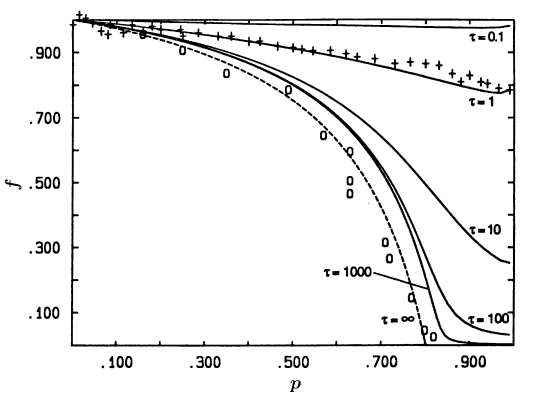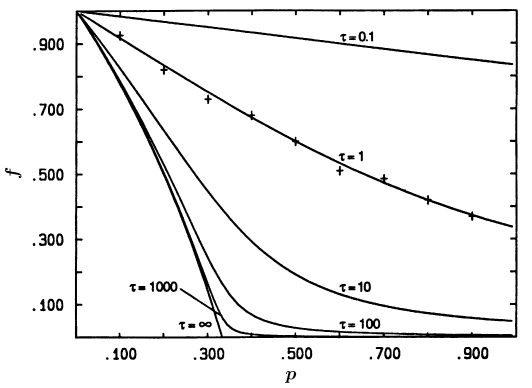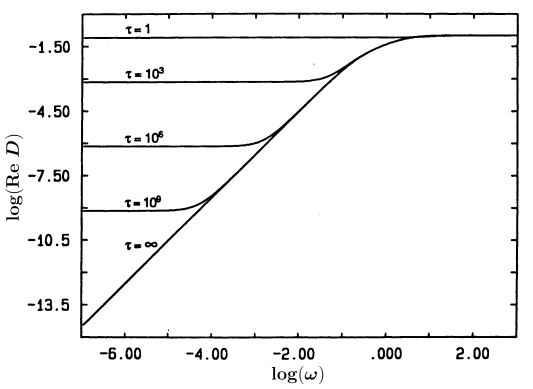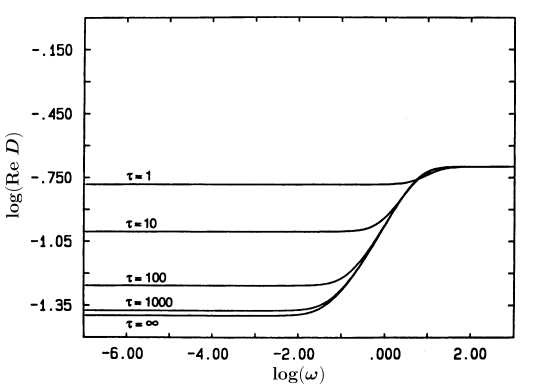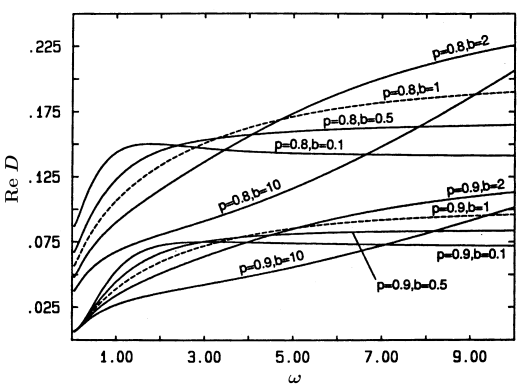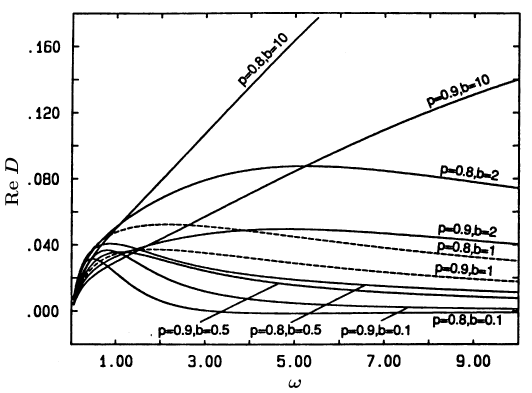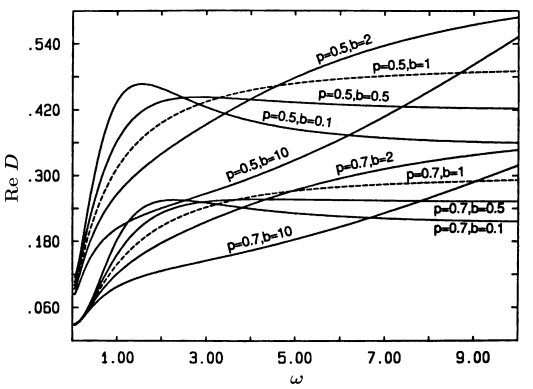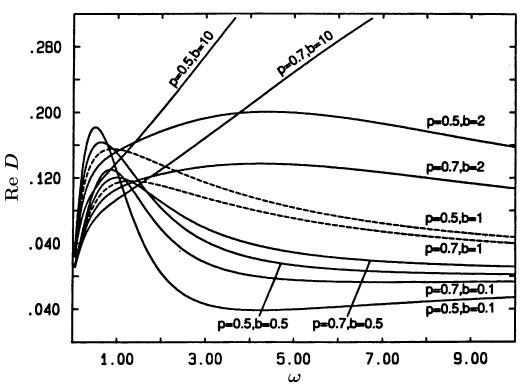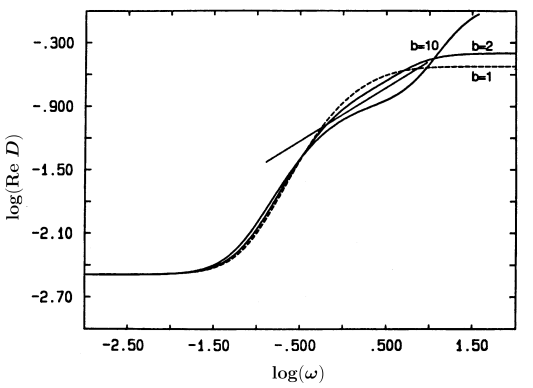5 Results
[190.1.1] The results for ω=0 will be expressed via the so called correlation factor f.
[190.1.2] It is a measure which is often used to characterize the amount
by which the self diffusion coefficient of a tracer particle in a lattice gas
differs from its mean field value given by the vacancy concentration.
[190.1.3] All results will be presented and discussed with the conventions ω=1,
p′′0=1, and assuming a unit lattice constant.
[190.1.4] In these dimensionless units f is defined by the equation D0=f1-p
or, more generally,
because for our hopping models 1-p=D∞.
[190.1.5] In the limit p→1 exact results for the correlation factor
are known for the case τ=1 (and b=1)[11, 13, 14].
[page 191, §0]
[191.0.1] For the hexagonal lattice one has f=1/3,
while f=0.781.. for the fcc lattice.
[191.0.2] These values will be used below to determine c in eq. (4.2).
[191.1.1] We now have to solve eq. (3.10)
in conjunction with eqs. (3.13) and (4.4)
for the cases of interest, the hexagonal and face centered cubic lattice.
[191.1.2] The lattice Greens functions for these situations are well known
and can be expressed in terms of the complete elliptic integral of the first kind
| Km=∫0π/21-msin2ϕ-1/2dϕ. | | (5.2) |
[191.1.3] For the hexagonal lattice we have
| Gx=-23+xπ2+x3/26+x1/2K16x+3x+23x+6. | | (5.3) |
For the fcc lattice the Greens function is given by
| Gx=-1π24+x-1Kx+Kx- | | (5.4) |
where
| x±2=4+x4-21164+x41/2-x41/24+4+x41/2±3+x41/2. | | (5.5) |
[191.1.4] We now solve eq. (3.10) iteratively on the computer.
[191.1.5] We stop the iteration when the maximal relative error
between two consecutive solutions falls below 108.
[191.1.6] The resulting A0u is then used to calculate Du
according to eqs. (3.13) and (4.4).
[191.1.7] The results are displayed in Figures 2 through 10.
[191.2.1] First we determine the proportionality constant c in eq. (4.2).
[191.2.2] This is achieved by requiring that the calculated correlation factor
reproduces the known exact results for the limit p=1,τ=1,b=1.
[191.2.3] We find chcx≈1.00for the hexagonal lattice,
and cfcc≈0.16for the fcc lattice.
[191.2.4] These numbers are difficult to determine numerically,
and we estimate the error to be roughly 0.03.
[191.2.5] In all subsequent calculations we then use these values for c.
[page 193, §1]
[193.1.1] In Figure 2 we have extracted the correlation factor from D0
and plotted it versus blocker concentration p.
[193.1.2] All curves are for the uncorrelated case,
i. e. b=1, on the fcc lattice.
[193.1.3] We give results for τ=0.1,1,10,100,1000and τ=∞.
[193.1.4] The crosses are the results of the Monte Carlo simulation
for the case τ=1 taken from Ref. [7].
[193.1.5] The circles are MC-results for τ=∞
and were taken from Ref. [10].
[193.1.6] Clearly there will be a discrepancy for this case
because our results are approximate and for bond percolation
while the simulation is exact and for site percolation.
[193.1.7] An immediate problem is the value of pc
for which the effective medium theory gives
pc=1/6 while the exact value is pc=0.198.. [8].
[193.1.8] If we simply use the exact value for pc in our calculation
we obtain the dashed line displayed in Fig. 2
which is found to be in good agreement.
[193.1.9] In Fig. 3 we plot f vs. p for the hexagonal lattice.
[193.1.10] Here the simulations have been taken from Ref. 10.
[193.1.11] Keeping in mind that there are no free parameters (remember b=1)
we find very good agreement for both lattices.
[193.1.12] However, additional simulation data especially for τ
in the range 1<τ<∞, and a more accurate determination of c
are required to fully evaluate the quality of the theoretical results.
[page 194, §0]
[194.0.1] We now turn to the results for our primary objective,
the frequency dependent diffusion coefficient.
[194.1.1] We consider first the uncorrelated case b=1 on the fcc-lattice.
[194.1.2] In Figure 4 and Figure 5
we plot ReDω over ten decades in frequency on a log-log plot.
[194.1.3] Figure 4 corresponds to a blocker concentration p=0.9
which is below the percolation threshold for vacancies,
and shows the results for
τ=1,103,106,109and ∞.
[194.1.4] Figure 5 has p=0.8 and
τ=1,10,100,1000.
[194.1.5] From Figure 4 we see immediately that below the percolation threshold Dω
vanishes quadratically with frequency for τ=∞.
[194.1.6] This behaviour is well known from the analysis
of the EM theory for the frozen case.
[194.1.7] For τ<∞ we find a crossover to a constant proportional to 1/τ.
[194.1.8] This could have been expected because the blocker motion now allows the Aâparticle to get
through the network although the vacancy concentration at each instant is below pc.
[194.1.9] The mobility of the A-particles will be completely determined
by the mobility of the blockers.
[page 197, §0]
[197.0.1] The crossover frequency is seen to vary as ωτ∼τ-1/2.
[197.0.2] This will be discussed further in the next section.
[197.0.3] On the other hand above the vacancy threshold Figure 5
shows that the effect of the blocker rearrangement is only noticeable
for τ values smaller than roughly 104.
[197.0.4] Indeed one expects that the effect of blocker motion
will become negligible if 1/τ is much smaler
than the d. c. conductivity in the frozen case
which is proportional to 1-p-pc.
[197.1.1] In Figures 6 and 7 we now turn to the correlated case, i. e. b≠1.
[197.1.2] Again we consider the fcc-lattice and plot the real (Fig. 6)
and imaginary (Fig. 7) part of Dω
for the two concentrations p=0.8 and p=0.9
with fixed τ=100 but variable b.
[197.1.3] We have chosen b=0.1, 0.5, 1, 2, 10 for the correlation factor.
[197.1.4] The case b=1 is included as a reference
and has been distinguished graphically by a dashed line.
[197.1.5] As before the real part approaches a constant as ω→0
irrespective of p because τ is finite.
[197.1.6] A new phenomenon however is the appearance of nonmonotonous
behaviour for b=0.1.
[197.1.7] In this case ReDω is found to increase at low frequencies,
and to decrease at high frequencies
thereby exhibiting a maximum at a finite frequency.
[197.1.8] In general ReDω is found to decrease as b→0 at high frequencies,
and to increase at low frequencies.
[197.1.9] The reverse is seen for b→∞.
[197.1.10] This will also be discussed in the next section in more detail.
[197.1.11] For the imaginary part of Dω we find a change of sign
for sufficiently small b<1.
[197.1.12] See for example the case p=0.8, b=0.1.
[197.1.13] On the other hand for p=0.9, b=0.1
there is no change of sign in the imaginary part
while the real part still shows a maximum.
[197.2.1] The same calculations have been performed for the hexagonal lattice.
[197.2.2] The results are displayed in Figures 8 and 9.
[197.2.3] The only difference lies in the parameter values.
[197.2.4] We have chosen different concentrations, p=0.5, 0.7, b=0.1 and fixed τ at τ=10.
[197.2.5] The results show qualitatively the same behaviour as for the fcc-lattice.
[197.3.1] In Figure 10 we have plotted some results
for the correlated case (b≠1) in a log-log plot.
[197.3.2] We show ReDω for p=0.7, τ=100 and b=1,2,10
on the hexagonal lattice.
[197.3.3] We note that as a consequence of the correlations
the crossover into the constant high frequency limit
is smeared out and resembles a power law over more
than a decade in frequency.
[197.3.4] This is particularly apparent for the case b=2.
[page 198, §0]
[198.1.1] For reference we have included a straight line into the graph
whose slope is found to be roughly 0.5.
[198.1.2] We remark that such a power law behaviour
for the frequency dependent conductivity
is often found experimentally in disordered systems.
[198.1.3] As a particular example we mention Na-β-alumina
where the ionic transport is also known to be highly correlated[34].
